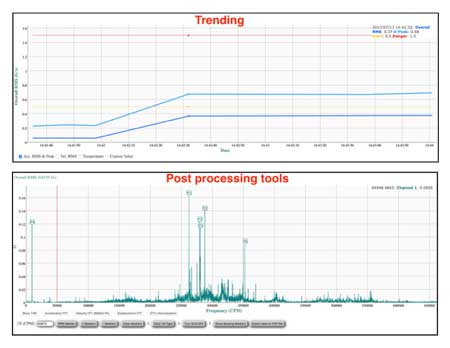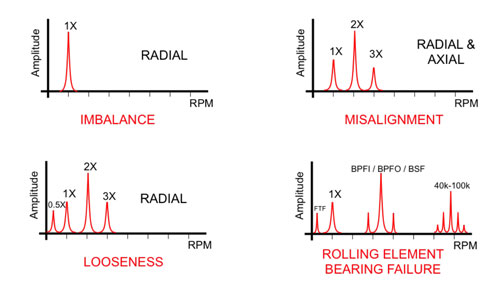How it Works and Why You Need It
We talk to a lot of people about spindle predictive analysis. In these conversations, we’ve learned that many companies are reluctant to invest in predictive analysis for their spindles. One comment we often hear is that people prefer to use their own “naked ear” to know when their spindles need maintenance or repair.
While listening is a helpful tool, when it comes to spindle maintenance, it’s more of a “last line of defense” tool than a front-line tool. If you can hear something wrong in your machining equipment, you’re often too late to avoid costly spindle repairs or replacement. Why? Most damage was done long before you could hear it happening.
The crux of what is often misunderstood about predictive analysis for spindles is that, yes, you can avoid the upfront cost of a predictive solution by relying on your own ears and waiting until you hear a problem. But your ears are not nearly sensitive enough to detect the early problems.
You not only miss out on the considerable reductions in repair costs, but also have to suffer through the unplanned downtime that a predictive solution helps you avoid. In practice, spindle predictive analysis tools allow you to hear problems in their earliest phases before they grow into much more complex (and expensive) issues.
The Value of Spindle Predictive Analysis Data

The key to developing a full understanding of spindle predictive analysis is recognizing the value of timely and accurate data. After all, the collection and analysis of data is the primary purpose of predictive analysis solutions.
Predictive analysis utilizes a variety of testing methods to collect informative data. These include vibration analysis, thermography, and ultrasound. Let’s focus on the big one: vibration analysis. Not only are vibrations the most common indication of stress in CNC machining processes, but they also can represent the most damaging threats.
Another word for “vibration” is “frequency. As a healthy, well-balanced spindle turns it creates a specific frequency. Predictive tools monitor this frequency and watch for changes. And just as humans make sounds with our larynxes to share information — or data — with each other, your equipment’s vibrations are sharing data with you. Should a bearing start to wear or the spindle become out of balance, the frequency change is obvious, and corrective actions can be taken.
Unfortunately, no matter how finely tuned your ear is, you’re physically limited in regard to the range of vibration that you can perceive. A spindle vibration detection and analysis system, on the other hand, can perceive subtle changes far sooner than humans can — and alert you to the changes before it’s too late.
What Vibration Analysis Does
A vibration analysis system monitors these frequencies (vibrations) and helps you understand what’s vibrating, how it’s vibrating, and even why — and it can give you important clues to the failures that these vibrations can lead to.
Some of the conditions that vibration monitoring can reveal include:
- Spindle Bearing health— Bearing failure is a natural phenomenon; vibration monitoring makes tracking bearing lifecycle simple, eliminating surprise failures when done properly.
- Imbalance — Often a tooling issue, but could be something else, such as a bad motor brush, for instance.
- Misalignment — Shafts that are out of alignment put strain on spindles, resulting in a loss of power transmission as well as damage to, and even failure of, the bearings, couplings, and other associated components.
- Looseness — Looseness in your CNC equipment manifests as vibratory sub-harmonic frequencies.
- Mechanical wear— Can occur in couplings, bearings, support structures, etc.
Other — These include machine drive issues, lubrication issues, and other failing internal components.
 Each of these problems causes different vibrations (frequencies) and, as you use and learn a vibration monitoring system, you’ll learn to spot the signs of each. Over time, the goal is to correlate what you see in the data with what’s specifically happening within the machine.
Each of these problems causes different vibrations (frequencies) and, as you use and learn a vibration monitoring system, you’ll learn to spot the signs of each. Over time, the goal is to correlate what you see in the data with what’s specifically happening within the machine.
Understanding the Data
It can seem intimidating to suddenly have access to all this data, especially before you’ve gotten a handle on how to interpret it. If you implement a high-quality spindle predictive analysis system, however, the software will help with the interpretation.
Even if you use a system like this at its most basic level — one measurement taken and recorded periodically — you’re going to see a benefit. After all, as they say, three pieces of data shows a trend, and, “a trend is your friend”. It gives you something to evaluate and compare over time.
The point is that if you are serious about reducing spindle repair and maintenance costs, and about minimizing unplanned downtime, doing the old ear check isn’t going to cut it. You need a robust set of current and accurate data — and spindle predictive analysis is the best way to get it.
